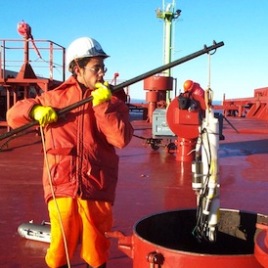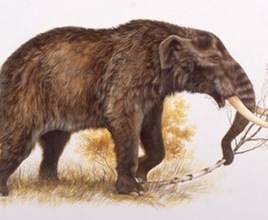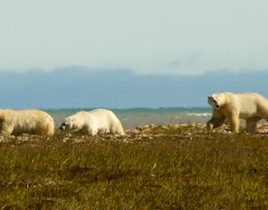Vaccinating teenage girls against the human papilloma virus (HPV) does not appear to increase risky sexual behaviour. There was concern that receiving the vaccination would cause an increase in such behaviour, however this study shows the concern is unfounded and should not prevent vaccinating girls at a young age. The study followed over 260,000 girls […]

Obesity may shorten life expectancy by 8 years
Individuals who are obese or overweight may be shortening their lives by up to eight years, according to a new study. In addition to this new decrease in life expectancy, obese and overweight individuals have a higher chance of developing diabetes or cardiovascular disease earlier in life. The study found that individuals who are overweight to […]
Fruit bats echolocate with wing clicks
Researchers have shown that Old World fruit bats – long thought to be non-echolocating species – use sound to help them navigate in the dark. Experiments showed that the fruit bats were making the noises not with their larynxes, but with their wing flaps. Although this form of echolocation is not as sophisticated as in […]

How risky is ballast water?
Many invasive species – e.g. zebra mussels – hitch a ride across oceans in ships’ ballast water, but a new study shows that some trips may pose more risk than others. Researchers sampled ballast water each day as ships crossed the ocean and discovered that invasive species are more likely to survive a shorter trans-Atlantic […]
Carbon dioxide warming effects felt 10 years after being emitted
It takes ten years for an emission of carbon dioxide (CO2) to have its maximum warming effects on the Earth, a new study shows. It was previously thought that the warming effects from a CO2 emission would not be felt for several decades. The authors conclude that benefit from avoided CO2 emissions, and thus avoided droughts, […]
Hospital deaths dropping in Canada
Hospital deaths continue to decrease across Canada, new data shows. Nearly 60 per cent (47 out of 83) of hospitals in Canada achieved a decrease in hospital deaths over the last five years. Hospitals have made strides in reducing mortality related to heart attack (down 19 per cent), sepsis (down ten per cent) and heart failure (down five […]

Resolving a mastodon mystery in the Yukon
A re-examination of mastodon fossils from Alaska and the Yukon indicates that they are much older than previously thought. Previous studies dated the fossils to the last ice age, about 18,000 years ago. However, at that time the area was largely grassland, and mastodons were forest-dwelling animals. The new study used modern radiocarbon dating methods […]
Researchers identify genetic mutation responsible for a serious disorder common in Inuit people
Inuit will now be able to be quickly diagnosed with a blood test for a genetic disorder that prevents the absorption of sucrose, causing severe diarrhea. Researchers have identified the genetic mutation responsible for the disorder, called congenital sucrose–isomaltase deficiency (CSID), which affects up to one Inuit out of ten. They have isolated DNA from the […]
Fighting malnutrition with ‘stronger’ chickpeas
Researchers have determined which genetic variations influence the iron and zinc concentrations in chickpea seeds, a finding that could help fight malnutrition in developing countries. The study examined 94 varieties of chickpea and found eight genetic variations – known as single nucleotide polymorphisms, or SNPs – that are associated with the iron and zinc concentration. Breeding […]
Atmospheric pollutant hides in the dirt at night
A new explanation for rising and falling concentrations of the atmospheric pollutant nitrous acid (HNO2 ) could help predict ‘smog days’. Nitrous acid is quickly destroyed by sunlight in the atmosphere, but nevertheless it can build up to detectable levels during the day, pointing to an unknown source. The new study explains how HNO2 created […]

Super-Earth spotted from ground level
For the first time, astronomers have used a ground-based telescope to observe a ‘super-Earth’ – an exoplanet twice as big as the Earth – pass in front of a nearby Sun-like star. Currently, most Earth-like exoplanets are discovered by space-based telescopes like NASA’s Kepler. Scientists hope that future space telescopes such as TESS in 2017 and PLATO […]
Treatment for Type 1 diabetes shown to work on human pancreas cells transplanted into mice
An amino acid produced by pancreas was shown to prevent and even reverse Type 1 diabetes in mice injected with human pancreatic cells, a new study shows. Type 1 diabetes is a disease that cause the immune system to destroy insulin-producing cells, called Beta cells. Researchers had already shown back in 2011 that the amino […]

La fonte des glaces menacera le quart des ours polaires d’ici 2100
Une nouvelle étude montre qu’un quart des ours polaires pourrait disparaître d’ici 2100 si rien n’est fait pour contrer le réchauffement climatique. Des chercheurs ont utilisé un modèle climatique afin de modéliser la couverture des glaces dans l’archipel arctique canadien. Ils concluent que d’ici 2100, les ours polaires devront survivre à un environnement sans glace […]

Melting ice could jeopardize 25% of polar bears by 2100
A new study suggests that if arctic warming trends continue, a quarter of the world’s polar bears will be unable to survive by 2100. The study uses a climate model to create detailed projections for the ice cover in the Canadian Arctic Archipelago, the series of islands and channels that dominate the far North of […]
Les mésanges à tête noire s’adaptent pour suivre les variations météorologiques
Les mésanges à tête noire augmentent leur capacité de production de chaleur en réponse à la diminution de la température jusqu’à atteindre une capacité maximale à -10°C. Cette étude est la première à caractériser le lien entre le changement de température et la variation de production de chaleur et à mettre en évidence les limites […]
Chickadees can resist cold down to -10°C
Black-capped chickadees’ ability to resist cold temperatures by increasing their own heat output maxes out at about -10 degrees Celsius, according to a new study. After that point, they seek shelter from the cold rather than remain outside dealing with it. The study is the first to suggest that birds have a limit on their […]
